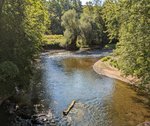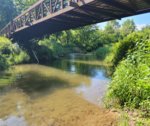


It is finally time to hang up the waders for the year. From May to September, Soil and Water Conservation Districts (SWCDs) in the Cannon River watershed have been collecting water samples from various lakes and streams in the watershed.
The sampling project is part of a larger effort for the Cannon River Watershed, as county and SWCD officials are now beginning implementation of the Cannon River Comprehensive Watershed Management Plan (CRCWMP) which was developed to improve the quality of water in the Cannon River and its streams and lakes.
The Minnesota Board of Water and Soil Resources officially approved the CRCWMP in June 2020. The plan was developed by the Cannon River Watershed Joint Powers Organization (CRWJPO).
The data that is collected from area lakes and streams will be used by the Minnesota Pollution Control Agency (MPCA) and the CRWJPO to manage the cleanup of our public waters. “The primary objective of this program is to determine the health of lakes and streams in Minnesota. Through funded projects, local partners collect data on surface water quality to identify lakes and streams that are in need of restoration or protection strategies” (MPCA 2022).
The water samples that are collected get tested for Total Phosphorous (TP), Chlorophyll-a (Chl-a), Chloride, Sulfate, Hardness as Calcium Carbonate (CaCO3), Total Suspended Solids (TSS), and E. Coli at the lab. Temperature, pH, Dissolved Oxygen (DO), Specific Conductance, and Secchi tube/disk readings are collected by SWCD staff. Let’s take a closer look at some of these tests and why they are important.
Total phosphorous (TP) measures the amount of phosphorous in the water. This includes the dissolved and particulate forms of phosphorus. If there is a high level of total phosphorous found in a water body, it means that there is a lot of food for algae. This would then cause a high concentration of algae, which can lead to algae blooms; that yucky, green, soupy water that takes over our area lakes during the summer months. Phosphorus washed downstream to the Mississippi River also contributes to the hypoxic dead zone in the Gulf of Mexico.
Chloride contamination is a growing problem for both freshwater and groundwater resources in Minnesota. Chloride is a salt and can enter the watershed from being spread as a deicer in the winter or from the discharge of household salt water softeners. Water samples are tested for the amount of chloride in the water. High amounts of chloride can be toxic to aquatic fish and vegetation.
Testing for e. coli can let us know if there is a presence of fecal waste in the water. Fecal waste can enter surface water through feedlot runoff, failing septic system discharge, or pet waste that gets washed away. It can also enter water bodies naturally from wildlife. Ingesting e-coli can cause diarrhea, vomiting, cramps, nausea, headaches, fever, fatigue, and even death in some cases. It can also lead to the closing down of area beaches, impacting swimming and other recreation on area lakes.
Dissolved oxygen (DO) is measured because a certain amount of oxygen is required in water for aquatic life to survive. If the DO is low, it could cause stress to most aquatic organisms. Low oxygen levels occur when algae dies and decomposes in an aquatic system. This happens because oxygen is used in the chemical process.
When these tests are collected, interpreted, and reviewed, they can be used to help determine the health of a lake or stream. If a water body is determined to be impaired, then action can be taken to find the source of the impairment and corrective management strategies can be implemented.
Improving water quality can be achieved by controlling soil erosion with cover crops, grassed waterways, and sediment basins, as well as erosion control measures around construction sites. Preventing e-coli contamination can be accomplished with ag waste storage systems, manure management, updating septic systems, and picking up pet waste from our backyards. Chloride contamination can be prevented by using best management practices when applying salt. With how important our water resources are in Minnesota, it is imperative that we do what we can to help keep our waters clean and healthy.
If you would like to learn more about the Cannon River Comprehensive Watershed Management Plan, visit https://www.riceswcd.
Kourtney Hammerschmidt is a District Technician with the Rice Soil & Water Conservation District. She assists landowners with buffer implementation and the district’s cover crop/custom interseeding program. She also helps to coordinate water testing in the Cannon River Watershed. Contact Kourtney with your questions at 507-332-5408.